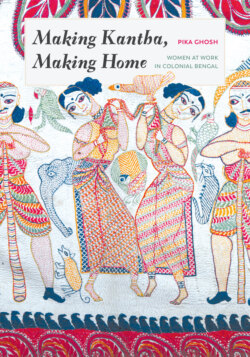Making Kantha, Making Home

Реклама. ООО «ЛитРес», ИНН: 7719571260.
Оглавление
Pika Ghosh. Making Kantha, Making Home
CONTENTS
ACKNOWLEDGMENTS
A NOTE ON TRANSLITERATION
Introduction. Kantha, Comfort, and Canon
CANONS, CONSTRAINTS, AND MISFITS
FABRICATING DOMESTICITY
KANTHA AND THE MARITIME TRADE IN COLCHAS
LISTENING FOR WOMEN’S VOICES
CHAPTER 1. Layers, Thickness, and Resonance. Making Home, Making Whole
MANY HANDS, HOMES, AND IMAGINARY HOMELANDS
TRANSITIONS AND COPING MECHANISMS
INTERIORITY, INTIMACY, AND RAPTURE
CONFIGURING OWNERSHIP
CONSTRUCTING LINEAGES
RESONANT TRACES
CHAPTER 2. Manadasundari’s Gift. Worlds in the Household
EMBROIDERING ON EMPIRE
MIXING MESSAGES AND MEDIA
FASHIONING FACADES
CONSTRUCTING THE BABU
SYCOPHANTS, ATTENDANTS, AND DEPENDENTS
LOOKING FOR MANADASUNDARI
CHAPTER 3. Kamala’s Mandala. A Space of One’s Own
LANDSCAPES OF INTERIORITY
AT HARI’S FEET
ENTANGLED BODIES AND FANTASTIC HORSES
PLEASURE RIDES AND MASQUERADES
INTIMATE MIRACLES
A SPACE OF ONE’S OWN
Conclusion. Some Loose Ends
NOTES
CHAPTER 1. LAYERS, THICKNESS, AND RESONANCE: MAKING HOME, MAKING WHOLE
CHAPTER 2. MANADASUNDARI’S GIFT: WORLDS IN THE HOUSEHOLD
CHAPTER 3. KAMALA’S MANDALA: A SPACE OF ONE’S OWN
BIBLIOGRAPHY
INDEX
Отрывок из книги
Padma Kaimal
K. Sivaramakrishnan
.....
I.15. Kamala’s kantha. Attributed to nineteenth century. Collected by Stella Kramrisch. 95.2 × 95.3 cm. Philadelphia Museum of Art: Gift of Stella Kramrisch, 1994-148-705.
Their narratives, moreover, elide the complex processes of acquiring textiles that once belonged in homes and families, often with the names of makers, recipients, and personal messages in visual and textual stitched form. As they laid the groundwork, creating awareness through collecting kantha, housing the material in newly established museums and curating exhibitions, ironically, the voice and valorization of kantha as a women’s spiritual practice was predominantly from an elite male intellectual cohort. As art historian Debashish Banerji has reminded us, Abanindranath Tagore acquired material for such work from the women of his intimate family circle in the Jorasanko household and through observation of the practices of its women.68 Likewise, the pioneering efforts of Saroj Nalini Dutt toward institutionalizing vocational training for women, including sewing, weaving, and embroidery, is hardly a footnote in studies of Bengali history;69 the enthusiasm of her husband, Gurusaday Dutt, on the other hand, is noted assiduously in analyses of women’s upliftment efforts. If the scholarship on the manifold collaborations between colonial anthropologist and native informant has been the subject of intense scholarly scrutiny, such intimate alliances equally complicate the prevailing picture of male scholars speaking on behalf of vast numbers of women, who remain unacknowledged, and often unnamed. Furthermore, if predominantly male-authored ideologies were projected on the body and sphere of influence of Bengali women, not all Bengali women were so privileged. Rather, it was unambiguously the woman who was married, bore children, and took care of the family and household.70 Younger girls, prostitutes, unmarried or widowed women, and other women who did not fit the dominant image of the Bengali woman as wife and mother were excluded from the idealization that was simultaneously under construction.71
.....